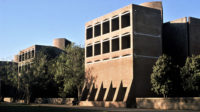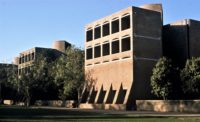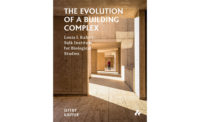You Say to Brick: The Life of Louis Kahn
By Wendy Lesser

You Say to Brick: The Life of Louis Kahn, by Wendy Lesser. Farrar, Straus & Giroux, 416 pages, $30.
The fruit of years of assiduous research, Wendy Lesser’s study of Louis Kahn synthesizes his life and work in a literary equivalent of an architectural composition: Lesser’s account oscillates between episodic segments of a life story told in reverse and her own equally episodic experience of five of his major works—the Salk Institute in La Jolla, California (1963); the Philips Exeter Academy Library in Exeter, New Hampshire (1971); the Kimbell Art Museum in Fort Worth (1972); the Indian Institute of Labor Management in Ahmedabad, India (1974), and the posthumously completed National Assembly in Dhaka (1983).
Lesser’s biographical résumé begins with a chapter entitled “Ending” emphasizing the strange circumstance of Kahn’s death on March 17, 1974, in the men’s room of Penn Station, New York. This somewhat sordid demise is bookended by a final chapter entitled “Beginning,” where Lesser’s evocative prose describes the accident that scarred Kahn’s face for life, when as a child he inexplicably played with embers that burst into flames. Equally evocative are the author’s sensitive responses to Kahn’s architecture, which, at times, make you feel that, no matter how often you revisit the work in question, you have yet to be affected by it as profoundly as the author. At the Salk Institute, she responds kinesthetically to the acoustical effects of the fountain in the courtyard where the water perpetually flows in an axial channel as it descends toward the sea. She has an equally tactile response to the smooth concrete, pitted travertine, and weathered teak in the flanking structures. It is significant that the reiterative geometry of the central core of the Exeter library could not be appreciated with the same phenomenological intensity as the Salk, despite the reassuring presence of its foursquare, warehouse-like brick facade.
In the last analysis, this biography is as much about Kahn’s unconventional, scandalous personal life as it is about his professional and artistic achievements. More importantly for the record, Lesser acknowledges many of Kahn’s partially neglected collaborators, in addition to the more familiar leadership roles played in the office by such figures as Marshall Meyers and David Wisdom. As an observant member of the office, Henry Wilcots, remarked, “Of course everyone knew that there was only one architect in the office, and that was Lou. Yet Lou was in and out. Dave held things together.” Thus Lesser’s biography serves to remind us that a work of architecture is never the result of one individual but the consequence of the continual involvement of innumerable persons who develop skills and crafts over a long period of time. To this end, many somewhat obscure figures appear in this biography, including Bangladeshi architect Shamsal Wares, who also features prominently at the end of Nathaniel Kahn’s 2003 film about his father, My Architect. Wares was one of the few to see that an essential aspect of Kahn’s vision was his involvement with the past. As Wares says, “Mies, Corbu were all forward-looking architects, interested in the formation of a new world order. Louis Kahn was the only one . . . who could understand the value of looking backwards.”
This book is enriched by insights of this order, but, because there are endnotes without corresponding numbers embedded in the text, the reader could miss the context in which such remarks were made. Nevertheless, these aphoristic citations fill innumerable gaps in our knowledge concerning the genesis of Kahn’s most memorable buildings.
The decision to put Kahn’s death at the beginning and the early scarring at the end—as well as the chapters in between entitled “Preparing,” “Becoming,” “Achieving,” and “Arriving”—have the net effect of conveying the sense of a highly creative but restless and disordered life. Consumed by work interspersed with emotional upheavals, Kahn was the last American architect, after Sullivan and Wright, who wanted to create a modern architecture that would rival the ruined heroic civilizations of the antique world.





